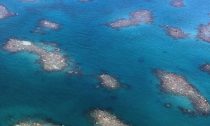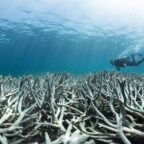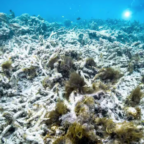
A cyclone in the Coral Sea has helped to ease widespread coral bleaching on the Great Barrier Reef, an expert said, after the marine park weathered its hottest month of sea temperatures on record.
The BOM forecast a tropical cyclone would form off the north Queensland coast over the weekend, and that severe weather over the central and north Queensland coasts would ease.
“The (sea) temperatures have dropped quite suddenly because of this weather system,” said Professor Terry Hughes from the ARC Centre for Excellence in Coral Reef Studies.
The cooler change comes at a critical time for the health of the reef.
Figures produced by the BOM showed sea surface temperatures in the marine park in February were hotter than in any month since 1900 — and hotter even than during the record bleaching events of 2016 and 2017.
“We know there is mortality out there. But we don’t yet have the big picture and the bleaching is still building despite this cooler weather. We think it’ll peak in another week or so.
“Satellite maps are showing that coastal waters are much hotter than mid-shelf and offshore waters, which would lead you to predict that the most severe bleaching this time is likely to be coastal. But we need to confirm that.”
David Wachenfeld, chief scientist for the Great Barrier Reef Marine Park Authority, said he was concerned by satellite maps indicating significant heat stress.
He said some parts of the reef had undergone more heat stress than in 2016 and 17.
“Central and Southern coastal areas look worse,” Dr Wachenfeld said.
You can see it with your own eyes’
On Monday, marine biologist Victor Huertas documented coral bleaching near Magnetic Island, less than 5 kilometres from Townsville.
“I didn’t expect the scale of the bleaching,” Mr Huertas said.
“I thought I’d find isolated bleaching here and there. But when I jumped in the water, the story was quite sad.
“A large portion of the corals were either bleached or dead or starting to fluoresce, which is what occurs when the corals start being stressed by high temperatures.
Large scale aerial surveys to begin
Next week, the ARC Centre of Excellence for Coral Reef Studies will begin aerial surveys of the reef to map the extent of coral bleaching.
“We’re planning to fly over about 700 reefs and we score them from the air in terms of the severity of the bleaching,” Professor Hughes said.
“We’re hoping for a map that’s not nearly as severe as 2016 and 17. But we won’t know till we make those flights.”
Professor Hughes said it was difficult to make predictions about how much coral would die, as scientists had found corals were reacting differently after each marine heatwave.
“The Barrier Reef went through one hell of a natural selection event in 2016 and 17 that changed the mix of species,” he said.
“The proportion of the tougher ones went up. And there were proportionately less of the heat-sensitive ones.”
Bleached doesn’t always mean dead
“When the stress is very great or just high enough for a long enough time, that’s when the coral actually dies. But the only real way to know whether coral is surviving and recovering after bleaching or dying is to get in the water and look up close.
“And so we use both techniques, aerial and in water surveys to give us the overall picture of what’s happening on the reef.”
Cyclone a temporary relief
Sea temperatures were already starting to drop, said William Skirving, a senior scientist with the US National Oceanographic and Atmospheric Administration’s Coral Reef Watch project.
“That’s thanks to the low that’s happened here in Cape York and is due to turn into a cyclone as it moves down the coast sometime later this week,” he said on Thursday.
“The sad thing is that it’s going to very quickly move off the coast and leaves the reef again with clear skies.”
However, Dr Skirving said, dangerous sea temperatures should abate as heat from the sun waned in autumn.
Data from the first aerial surveys should start to come in as early as next week, giving a clearer picture of the impact of the February marine heatwave.
Until then, scientists like Dr Wachenfeld were reluctant to quantify the damage.
“I’m particularly cautious about making forecasts about the reef because both the climate is changing, coupled with coral communities that are different to anything we’ve ever seen before,” he said.














Social Profiles